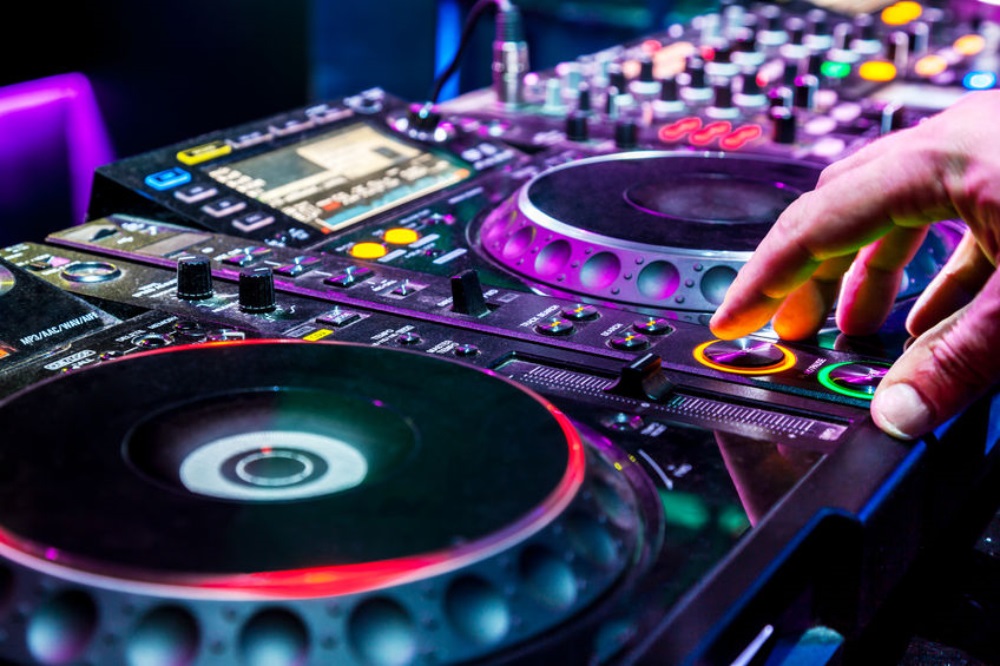About half of the gigs I do include DJs who either fill the downtime between band changeovers or have their own set time after the main show has ended, in addition to electronic music shows where the entire lineup consists of record-spinning, crowd-moving headphone-wearers.
Working with some great DJs (as well as some not-so-great ones) got me thinking of things that I’ve noticed help the great ones stand out.
Don’t use compressed audio formats
Consider a well-tuned, large-scale PA system as a magnifying glass that either amplifies the greatness of a source or amplifies the problems of a source. A source that’s not up to spec is clearly revealed and painfully obvious.
While the difference between a .wav and an .mp3 file of the same track might be barely noticeable or “good enough” on computer loudspeakers, headphones, and even in small clubs, a large system will reveal just about every flaw of compressed audio formats: loss of high-end detail, lack of punch, less attack in the low end, and harshness.
There are no tools that either DJs or a sound engineers have on their mixers that can cover up a fault at the source. None.
When I tell this to DJs, I usually get a response that they’re using the highest bitrate for their mp3s and that the average listener will not hear the difference. It takes just a simple test to make them realize that there is a different – play a track in a lossless format (i.e., wav) and the same track in the highest mp3 resolution. Run them on two separate channels and simply listen to an A/B comparison.
The difference is not subtle; it’s very noticeable. So if you’re serious about your sound (and I believe all great DJs are), move away from mp3 and toward lossless audio formats that retain the entire sonic image of a track.
Louder is not better
When doing soundchecks on a large scale PA, the sound engineer will match the output level from the DJ mixer to the correct input level on the sound system’s mixing console. Then, nine times out of 10, the engineer will also set a limiter just above that level.
A limiter is a dynamic processor that will (as the name suggests) limit the output level of a signal to a particular value, even if the input signal goes above that value. It literally “chops” off the transient peaks of the loudest detected signals. In electronic music, the most prominent energy comes from the beat, usually the low end of a kick drum, so it will start limiting there.
If a DJ starts pushing up the levels on his/her mixer, the signal will start distorting. It may not be noticeable at first, because it will be perceived as slightly louder, but it will also be harsher and much less pleasant to the audience. In this case, louder is definitely not better and often can be much, much worse.
To avoid the problem, set the DJ mixer at maximum level during soundcheck, then bring the starting point down so that there’s headroom to build as the set goes on. Also talk to the engineer or system tech about where the system limits are established to further maximize your set as well as protect the sound system (and your sound) at the same time.
Reduce volume on stage
I realize that in order to move the crowd, a DJ must not only hear but feel the music. That is why the monitoring systems for electronic music events are basically large enough to cover a small club, and yet are aimed at only one person. But a lot of the times these high levels have adverse effects and can be more destructive than helpful.
When the stage is too loud, especially at an indoor event, that excess energy will inevitably interact with the house sound system. In smaller, more contained spaces, this interaction can mask the direct sound for members of the audience, leaving them confused about where it’s actually coming from.
Also consider the negative impact that high sound pressure levels can (and will) have on your hearing, especially if the set is long and you do this on a regular basis. Employ hearing protection whenever possible, not only during your sets, but when listening to other acts. When our ears are fatigued, they need more volume for the same effect, and it becomes a vicious circle that never ends well.
In addition, a note for DJs using turntables: running levels too loud on stage will cause feedback. Consider the cartridge as a small microphone that can produce nasty feedback frequencies when it gets hit with high levels of sound.
To avoid these issues, train yourself to consciously start with a low monitoring level and slowly bring it up to a comfortable level. Also avoid falling into a trap of following DJs performing before you at the levels they had at the end of their sets– it’s invariably louder than what they started with.
Match the volume of individual tracks
Your tracks will inevitably come from various sources that use various dynamic processes, resulting in discrepancies between the tracks. As noted earlier, a large-scale PA is unforgiving and will expose all of inconsistencies in your set.
If you want to be in control of building the mood of the audience, first make sure that nothing takes them out of that mood. Jumping levels between tracks are a sure way of doing just that, breaking the connection you’ve been building.
Track preparation, so that all have equal levels, is a must.In addition, channel faders and/or gain knobs on your mixer can be utilized to reduce unwanted dynamics between tracks. Pre-Fade Listen (PFL) or CUE metering can also be very helpful in providing a visual representation of tracks that might adjustment. The bottom line is that you should be in control of what is accentuated during your sets.
Say “hi” to the sound team
Every large-scale event is staffed by a sound engineer and/or system tech operator, and I strongly advise making the effort to communicate with them, in addition to getting helpful information about the system and event.
You might learn that the gig you thought would be a loud dance party is actually a softer corporate show, or that there are level restrictions that need to be followed. Matching your vision with the reality of the actual gig before you get on stage can ensure that everyone involved is on the same page and working towards the same goal.
Plus you might get some useful tips in terms of your gear, cabling and other technical aspects that will serve you well in the future.















